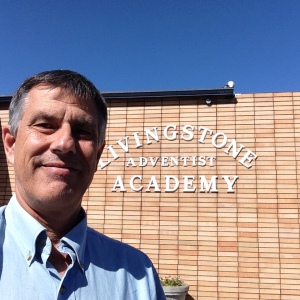
The sun was in my eyes. What can I say? Not all pictures can be great pictures. The important thing is I got a shot in front of a place that’s important to me.
I was privileged this past Thursday and Friday (June 11-12) to provide a Better Plan in-service to the staff at Livingstone Adventist Academy in Salem, Oregon. This was especially meaningful to me as my choice theory journey and the Soul Shaper book came out of my experience at Livingstone 20 years ago. I was principal of the school from 93-96. While several teachers (I always refer to the team I worked with as the Original Soul Shapers) from the mid-90s continued at the school until very recently, only one remains now, that being Chris Sequeira, who teaches History and Bible there. I was very pleased that the new team at Livingstone wants to learn about choice theory principles and consider ways to apply them in a classroom setting.

Chris Sequeira (on the right) and me in his classroom after the in-service was over, and just before we bid farewell to each other – him to see his daughter graduate from Walla Walla and me to head to PUC for graduation weekend.
With the in-service behind me now, like school teachers and workshop facilitators around the world, I am now in that place called reflection. How did the workshop really go? What did I do or what took place that worked? What could be improved? What needs to be tweaked to make it better the next time I do a two-day training? Reflection is the act of self-evaluating, and self-evaluation is a powerful part of choice theory. It’s not about beating myself up over not covering as much content as I wanted to, or not covering a concept as effectively as I would have liked. It’s about authentically (and compassionately) reviewing what took place and then modifying my lesson plan for the next go at it. I did the best I could; now I think maybe my best can be better.

The team at Livingstone seemed to resonate with the choice theory concepts. Most of them had read some or all of Soul Shapers before the in-service, so that helped. They had questions about some of the psychology pieces, but I didn’t pick up any “dealbreaker”responses. Their real questions, the tougher questions, had to do with how do you put these ideas into action? How, for instance, do you use choice theory with five-year-olds? How would choice theory affect classroom management in a high school classroom? What do you do with the kid who refuses to respond to reasonable choices or additional chances for success? These kinds of questions are similar to the challenges we all face. Choice theory sounds good, but how does it really work?
The title and subtitle on the syllabus I used at Livingstone read:
The Better Plan
Being What We Want Our Students to Become
The subtitle came to me as I was putting the finishing touches on the handouts, but the more I think about it the more I like it. There’s a lot contained in the phrase, “Being what we want our students to become.” For one thing, as teachers and parents we tend to focus on the behavior of our children or our students. In other words, we focus on what we want them to become. Choice theory reminds us, though, indeed thoroughly explains the importance of our first focusing on ourselves and what we bring to our homes and classrooms. Choice theory emphasizes the value of understanding our own being – our thoughts, our goals, our habits, and our beliefs. Only as I come into an appreciation of my own internal control design can I share the theory of that design with my students. Only as I come to see the sense of the axiom that the only person I can control is myself will I be better able to implement a classroom management plan that honors the internal control design of each of my students.

Our first focusing on our “being” as teachers does not mean that we cannot seek to guide and influence the behavior of our students. It is always interesting, though, when we consider how our own thinking and acting may have been a part of creating the problem we want changed. The clearer we see ourselves the better our management strategies will be.
Like Ellen White wrote over a hundred years ago –
“Let it never be forgotten that the teacher must be what he desires his pupils to become.” Fundamentals of Christian Education, p. 58
========================
Not that I want to compete with Amazon, but I can beat (sounds competitive) the Amazon price when it comes to the Glasser biography – Champion of Choice. Amazon’s price right now for the book and shipping is $30.17. My price for the book and first class shipping is $26, plus I will sign the book if you request it. (Media Mail shipping would be less.) Get in touch with me to order your copy at jimroyglasserbio@gmail.com. Expedite the order by sending me a check for $26, along with shipping instructions, to P. O. Box 933, Angwin, CA 94508.
